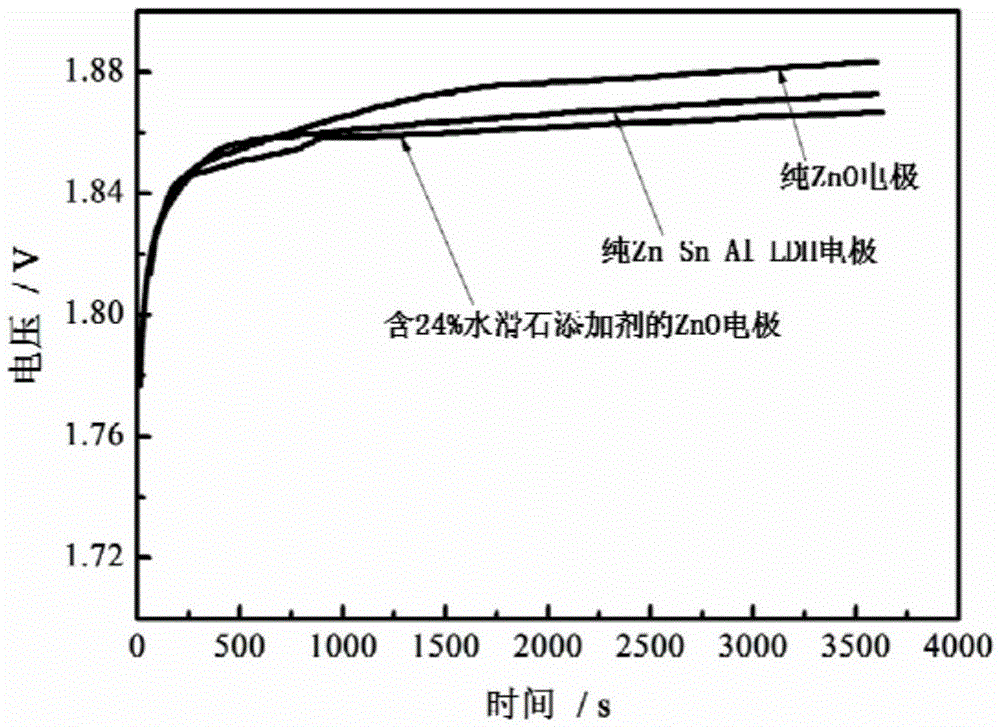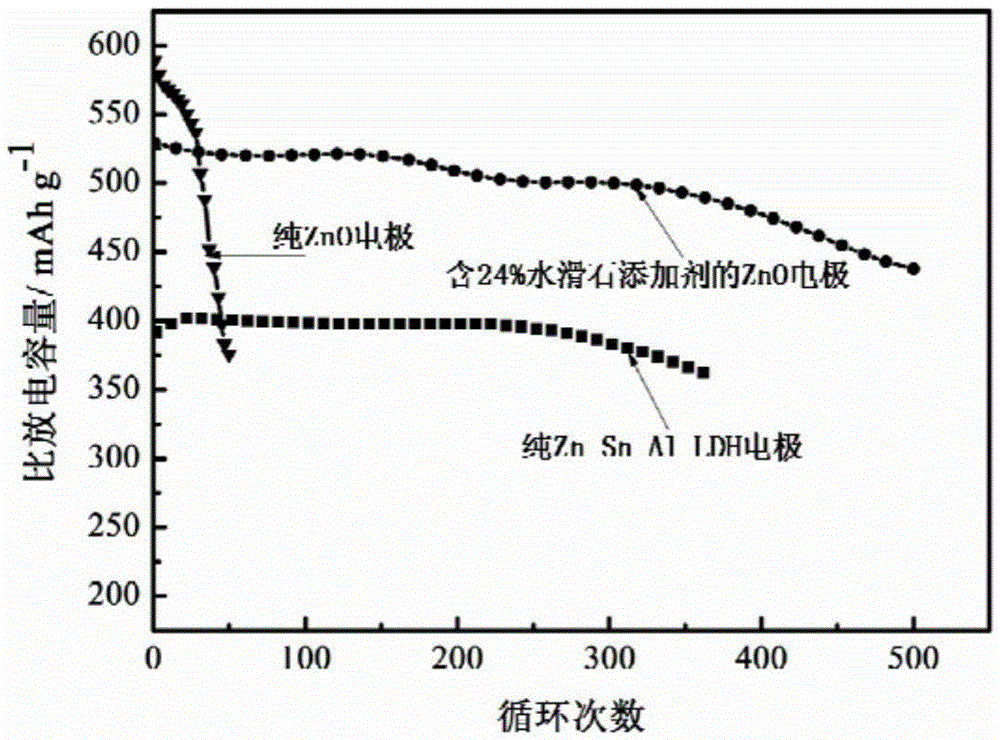A kind of application method of zinc negative electrode additive in zinc-nickel secondary battery
A secondary battery, zinc anode technology, applied in battery electrodes, circuits, electrical components, etc., can solve the problem of low specific discharge capacity, can not meet the needs of zinc-nickel secondary batteries, can not well improve the cycle performance of zinc anodes, etc. question
- Summary
- Abstract
- Description
- Claims
- Application Information
AI Technical Summary
Problems solved by technology
Method used
Image
Examples
Embodiment 1
[0033]36 parts by mass of analytically pure zinc nitrate hexahydrate and 10 parts by mass of analytically pure aluminum nitrate nonahydrate were dissolved in 100 parts by mass of deionized water, and 1.5 parts by mass of analytically pure tin dichloride was dissolved in 50 parts by mass of In dilute hydrochloric acid (0.1%), the above two solutions were mixed uniformly to form a salt solution. 3.2 parts by mass of sodium hydroxide and 2.12 parts by mass of sodium carbonate were dissolved in 50 parts by mass of deionized water to form an alkaline solution. Under strong mechanical stirring, drop the salt solution and alkali solution into a three-necked bottle filled with 50 parts by mass of deionized water under the protection of an inert gas at a rate of one drop per second, control the pH of the solution to 10.0, and continue stirring for 60 minutes , hydrothermal reaction at 120°C for 12h, and finally filter, wash the precipitate, and dry at 60°C for 12h to obtain the carbona...
Embodiment 2
[0036] The zinc-tin-aluminum ternary hydrotalcite additive 1.2g that embodiment 1 obtains, zinc oxide 2.8g, acetylene 0.5g, zinc powder 0.5g are ground in mortar and mix and obtain negative electrode material mixture; Sodium dialkylbenzene sulfonate was dissolved in 1ml deionized water, and the resulting solution was added dropwise to the negative electrode material mixture; 0.05g binder polyvinylidene fluoride was dissolved in 6ml deionized water, and the resulting solution was added dropwise to the negative electrode material mixture Then continue to grind to a uniform slurry; roll the slurry and the glass plate into a thin sheet with a uniform thickness with a glass rod, cut it into a 1cm×1cm square piece with a blade, clamp it on a 2cm×10cm copper mesh current collector, and press it The zinc negative electrode is made, and the positive electrode is a sintered nickel positive electrode sheet with a size of 5cm×5cm. The positive and negative electrodes are respectively clamp...
Embodiment 3
[0038] The zinc-tin-aluminum ternary hydrotalcite additive 1.5g that embodiment 1 obtains, zinc oxide 2.5g, acetylene black 0.5g, zinc powder 0.5g are ground and mixed in a mortar to obtain the negative electrode material mixture; 0.1g Sodium dodecylbenzene sulfonate was dissolved in 1ml deionized water, and the resulting solution was added dropwise to the negative electrode material mixture; 0.05g binder polyvinylidene fluoride was dissolved in 6ml deionized water, and the resulting solution was added dropwise to the negative electrode material Then continue grinding to a uniform slurry; roll the slurry and the glass plate into a thin sheet with a uniform thickness with a glass rod, cut it into a 1cm×1cm square piece with a blade, clamp it on a 2cm×10cm copper mesh current collector and press it The sheet is made into a zinc negative electrode, and the positive electrode is a sintered nickel positive electrode sheet with a size of 5cm×5cm. The positive and negative electrodes ...
PUM
 Login to View More
Login to View More Abstract
Description
Claims
Application Information
 Login to View More
Login to View More - R&D
- Intellectual Property
- Life Sciences
- Materials
- Tech Scout
- Unparalleled Data Quality
- Higher Quality Content
- 60% Fewer Hallucinations
Browse by: Latest US Patents, China's latest patents, Technical Efficacy Thesaurus, Application Domain, Technology Topic, Popular Technical Reports.
© 2025 PatSnap. All rights reserved.Legal|Privacy policy|Modern Slavery Act Transparency Statement|Sitemap|About US| Contact US: help@patsnap.com



